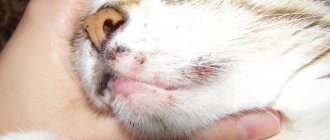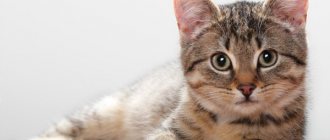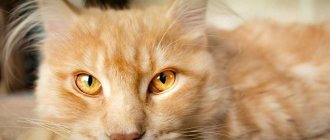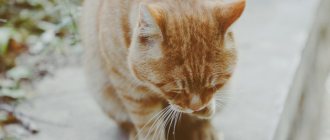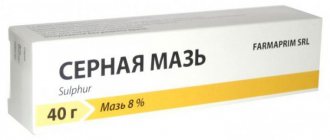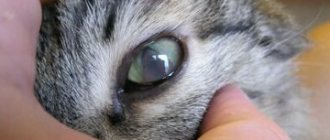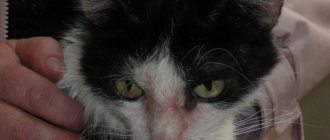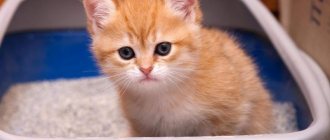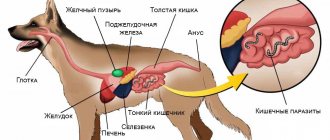What is dysbiosis and what causes it?
Dysbacteriosis (dysbiosis) is not a separate pathology, but a broad term denoting the replacement or death of bacteria that form the natural normal microflora. Their place is filled by pathogenic bacteria and E. coli and begin to develop rapidly.
The process involves all body systems, mucous membranes and muscles.
Factors that provoke dysbacteriosis include:
- Poor living conditions (unbalanced diet, vitamin deficiency, predominance of fats and carbohydrates in food, insufficient indoor air humidification, drafts, dry low-quality food, etc.).
- External reasons (change of residence, unfavorable environmental conditions).
- Disorders of the hormonal system, which can be caused by pregnancy, taking medications (including contraceptives).
- Liver, kidney failure.
- Psycho-emotional stress. Stress can be associated with a change of owners, the appearance of another pet in the house, the loss of offspring and other factors that negatively affect the animal’s psyche.
- Long-term, repeated antibiotic therapy is the most severe case of dysbiosis. As a rule, even one course of antibiotics is harmful to the animal. As a result, normal microflora is replaced by pathogenic microorganisms that are resistant to the effects of medications.
- Worm infestation.
Dysbacteriosis can develop in any animal. Artificially bred cat breeds are most susceptible to this condition - Scottish, British, etc.
Why is dysbacteriosis dangerous? To answer this question, you need to understand what function the intestinal microflora performs. This is a kind of protective barrier that protects the body from the effects of pathogenic bacteria, fungi, and viruses.
In addition, it stimulates and activates the immune system in kittens, neutralizes and removes toxins from the body, regulates metabolism and the activity of the hormonal system.
If signs of dysbiosis are detected, it is necessary to contact a veterinarian as soon as possible, otherwise the pet’s body will be completely defenseless against pathogenic microorganisms that cause dangerous diseases.
What is a disease
First of all, this is a disease that is difficult to detect with the naked eye. Secondly, this disease has a detrimental effect on the animal’s body and intestinal microflora, and also destroys the immune system.
Often, dysbiosis is similar to ordinary poisoning, which is accompanied by a lethargic state of the cat. Only experienced breeders can determine the presence of the disease without medical intervention.
The role of microflora in the body
What is microflora and why is it necessary to care about its quality?
In the body of every living creature, microflora performs important protective functions. The main task of microflora is to protect a specific organ from invasion and further proliferation of microbes. It is also directly involved in the biosynthesis of certain vitamins and in other processes that occur in the body.
After birth, the kitten acquires microflora characteristic of the environment in which it lives; it also depends on the state of its health and immunity. However, this does not mean that the microflora is acquired once and for all. During life, its composition constantly changes depending on the conditions of detention, age, and so on. Dysbacteriosis in a kitten develops much less frequently than in adult cats, because after birth, the animal is still sterile.
Symptoms
Signs of pathology appear suddenly. The cat looks depressed, sick, and shows no activity. Appetite is absent or reduced, causing the animal to lose weight. The stool is liquid, sometimes with mucus and blood. There may be both diarrhea and constipation.
The wool loses its shine and does not look aesthetically pleasing. In representatives of long-haired breeds, the fur coat may thin out significantly.
In some cases, bloating and flatulence are observed. Such a clinical picture gives every reason to suspect dysbiosis, especially if the cat was recently treated with antibiotics.
Treatment of intestinal dysbiosis in cats
At the clinic, the cat will be prescribed a number of tests:
- Blood biochemistry, urine and feces analysis.
- Smear for the presence of worms.
- Diagnostic testing of the liver and pancreas.
If the diagnosis is confirmed, do not be alarmed; intestinal dysbiosis in cats is not transmitted to people or other animals and can be completely cured. If necessary, get rid of parasites and then prescribe the following complexes:
- Creating or maintaining a favorable environment for “one’s own” microflora. Bacteria that should be present in the body but have been suppressed are used.
- Treatment with probiotics - after cleansing the intestines, the “emptiness” is populated with bacteria typical for the animal.
- At the same time, the animal is given vitamins, drugs that relieve swelling, allergic reactions, and stimulate the immune system.
Full recovery occurs after 1–2 months of therapy.
Preventing the death of intestinal microflora is much easier than treating dysbiosis, especially in combination with other diseases.
As a preventive measure it is necessary:
- Carefully select food, avoid eating missing or inedible products - often, dysbiosis develops due to the ingestion of cellophane or paraffin casing of sausages.
- Do not use antibiotics unless really necessary. Be careful, “conveyor” clinics prefer to treat “everything” without thinking about the consequences. If treatment is still necessary, be sure to take care of restorative therapy.
- Cats of “artificial” breeds or those prone to illness are given a course of probiotics with bifidobacteria and lactobacilli 2-3 times a year.
Useful materials:
- Tobrex for cats Instructions for useTobrex drops contain a broad-spectrum antibiotic - tobramycin from the group...
- Cutaneous horn General description of the disease Cutaneous horn on the forehead or face (ICD 10 code - L57.0) -...
- Amlodipine for cats Instructions for use of Amlodipine: in medicine and veterinary medicine VetConsultPlus Information portal Therapy Brief characteristics…
- Fosprenil for cats Instructions for use Fosprenil is administered to a cat intravenously, intramuscularly or subcutaneously. If necessary, an injection is allowed in…
Treatment
If the diagnosis of dysbacteriosis is confirmed by laboratory tests, then do not panic. This phenomenon is not very pleasant and it creates a certain danger for the body. However, the pathology is not transmitted to other animals and humans, is successfully treated and does not cause complications.
Therapy lasts 1-2 months and is complex. Treatment is aimed at:
- cleansing the gastrointestinal tract;
- restoration of natural microflora;
- normalization of metabolism;
- strengthening the immune system;
- stabilization of the psycho-emotional background.
If the symptoms are pronounced, the cat is given activated charcoal, Smecta. In general, drug treatment includes vitamin therapy, antihistamines, and drugs that strengthen the immune system. Hormonal pills, including contraceptives, are prohibited!
Cleansing of the gastrointestinal tract is carried out using the drug “Fitoelita”. The dosage is determined individually by the veterinarian.
To restore the microflora, the pet is prescribed a special light diet. The diet consists of fermented milk products. Such nutrition restores microflora. The colonization of lacto- and sour-lactic bacteria has a beneficial effect on the gastrointestinal tract.
Prebiotics will become a nutrient substrate for beneficial microorganisms that displace pathogenic bacteria. They should also be in the diet. It is advisable to include foods such as bananas, asparagus, and Jerusalem artichoke in the cat's menu. Of course, it is unlikely that the fluffy will show interest in such food, but it is still worth adding them little by little to dishes.
Lactoferon is used only if it is recommended by a specialist.
To strengthen the immune system, a solution of Neoferon is indicated, which is administered intramuscularly or subcutaneously.
It is very important to help your cat cope with stress, for which she is given sedatives. The herbal preparation “Cat Bayun” has proven itself well. The composition includes mint, meadowsweet, sweet clover, motherwort, valerian root, St. John's wort, etc.
As for probiotics, normoflorins are mainly used. They effectively destroy pathogenic microorganisms and saturate the intestines with beneficial bacteria, renewing the biosynthesis of vitamins B1, B2 and K. In addition, probiotics promote the formation of acetic and lactic acids, which promote good absorption of vitamins, iron, and fats.
Do not underestimate the seriousness of dysbiosis. If left untreated, cats may develop gastritis, pancreatitis, gastroenteritis, allergies, hepatitis, and respiratory diseases along with the death of microflora. If treatment was carried out promptly and competently, the prognosis is usually favorable.
How to treat dysbiosis
After visiting a specialist, you will know how to treat your pet. Perhaps the veterinarian only identified a suspicion of dysbacteriosis. In this case, you need to change the animal's diet. Dairy products and light foods will be the most optimal. You definitely need to buy vitamins that a specialist will prescribe for you. With their help, you can restore your cat's microflora.
In this case, you need to know a few simple rules:
1. Create conditions for your pet that will ensure the restoration of microflora. And try to maintain such conditions even after your pet recovers. 2. It is also necessary to cleanse the animal’s body of toxins and all kinds of waste. How to do this, it is better to consult a specialist. 3. It is important that the so-called correct bacteria are present in the cat’s body. Special therapy using probiotics will help with this. 4. Consult your veterinarian about vitamin complexes. This way you can stimulate the animal’s immune defense. 5. And do not forget that during treatment you will have to be patient, since at least two months are allotted for therapy.
What to do at home
The owner is required to strictly comply with the veterinarian's instructions. All medications and their dosage are prescribed by a clinic specialist. Self-medication can aggravate the situation and have a detrimental effect on health.
The pet must be provided with good living conditions and protected from drafts. The cat's immune system is weakened, which means there is a high risk of contracting a viral disease or infection.
To relieve your four-legged pet from the accumulation of gases, you can give cumin or dill oil - 3-5 drops per day. If your cat suffers from constipation, castor oil will help.
To improve appetite, a decoction of dill, basil, yarrow, and coriander is given. Herbs are mixed in equal proportions, poured with hot water, infused and filtered. A cat needs 10 drops per day.
Traditional methods allow you to get rid of the symptoms of dysbiosis, but should not replace traditional treatment.
Causes of the disease
The causes of dysbiosis may be the following:
- Moving to another place of residence, violating the rules of keeping an animal, which includes harmful, low-quality food, lack of vitamins, humidity, room temperature and any other factors that can lead to serious stress, which will trigger the disease.
- Pathologies such as kidney and liver failure, hormonal imbalances. For example, pregnancy in a cat, age characteristics, use of hormonal drugs. Hormonal contraceptives are prohibited for pets with dysbiosis; in case of severe symptoms, animals are prescribed activated charcoal or smecta.
- Stressful situations, such as fear caused by certain circumstances or other animals, starvation, long absence of owners, and so on.
- Long-term treatment with antibiotics. Experts note that even one course of medication can cause serious harm. If the course continues for a long time, then the microflora is “populated” with harmful bacteria. This dysbacteriosis is difficult to treat and represents the most severe form of the disease.
- Damage to the body by worms.
Prevention
Dysbacteriosis can be prevented; it is enough to follow the simplest preventive measures known to every pet owner:
- Careful food selection. The use of economy-class food does not contribute to the health of pets. They provoke deviations in the gastrointestinal tract and allergic manifestations.
- Avoid feeding your cat food from “your table.” The diet should be balanced in fats, proteins and carbohydrates.
- Controlling cat food. Often the impetus for the development of dysbiosis is an accidentally swallowed fragment of sausage casing and other synthetic materials.
- It is advisable to use bottled water rather than raw water.
- Antibiotics are taken only as prescribed by a veterinarian. An experienced doctor will never prescribe them unless necessary. After use, restorative therapy (pro- and prebiotics) is carried out.
- Timely treatment of animals from parasites (once every three months). This applies not only to outdoor cats, but also to pets.
As for artificially bred breeds that naturally have a tendency to dysbiosis, it is advisable to give preparations with bifidobacteria and lactobacilli at least twice a year.
According to veterinarians, courses of probiotics will not harm even healthy animals, regardless of age. They will prevent dysbiosis, improve metabolism and strengthen the body as a whole.
